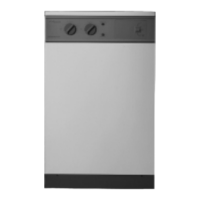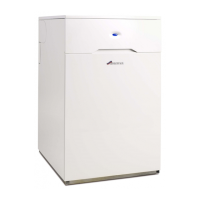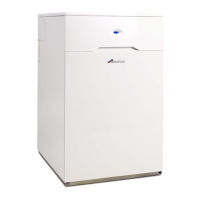8. COMMISSIONING
(a] Flush
the
who
le
system
w i
th
cold
water
and fill
until
the
pressure gauge registers
1.5bar(2
1 .
5p.s
.i.). Clear
any
air
locks and
check
fo
r water soundness.
(b)
Check operation
ofthe
safeW valve. Release
water
from
tile
system
u
nti
l
the
initia
l
system
des
ign
pressure
is
obtained. Taki
ng
into
account
any
difference in he
ight
betwee
n
the
pressure gauge
and
the
po
i
nt
at
which
the
pressu
re
vessel is
co
nn
ected.
NOTE: The initial system des
ig
n pressure
to
be
0 . 3 bar
(4
. 5
p.s.t.) p
lu
s
the
stat
ic head
of
the
sy
st
em
.
Tota
l pressure
must
not
exceed 1.5
bar
(21.5
p.s.i.).
(c) Light the boiler and heat t he
system
to
maximum
working
tem
per
ature
.
Check
for
water
soundness
.
Turn
off
sppliance
and
drain the
system
whi
le
it
is
st
ill
hot
.
(dl Refill and
vent
system.
Adjust
to
the in
it
ial
sys
tem design
pressure.
Any
set
po
i
nter
on
the
pressure gauge should be
set
to
coin
cide
with
the
indicating
po
i
nt~o;
.
11.
DOMESTIC
WATER
SUPPLY
See Fig.
24
.
NOTE:
The
following
i
nstructions
are
ge
neral
in
s
ta
l
lation
recommendations and reference should be made to the local
w
at
er u
nd
ertaki
ng
before fi
tt
ing any
of
these appliances.
In
the event of
diff
ic
ulty
please
contact
the
manufactu
r
er
.
1.
MAINS
COLO
WATER
IN
LET
Conn
ect
ion is
made
as
s
ho
wn
in Fig.
24
.
There should be
no
dev
i
ce
capable
of
preventi
ng
the
flow
of
expansi
on
water
un
less separate arrangements
for
expansion
water
are made. The final
600
mm
mains cold
wate
r
connect
i
on
to
the
ap
pliance shou
ld
be
made
in
copper only.
The appliance
is
su
i
table
for
connect
i
on
to
a mains supply
having
a
maximum
pressure
of
10
bar. (
146
l
b
fi
n
~
l
.
It
should
not
be
used
if
a pressure
greater
than
this
is
anticipated.
The app
li
ance is supplied w i
th
an isolati
ng
v3
1ve. This
should
be
fi
tted
to
the
cold
inlet
connection for appliance
servicing.
2.
HOT
SUPPLY AND
FLOW
REGULATION
No
ad
j
ustm
ent
oft
he
water
flow
is required
as
the
appliance
is
fitted
w i
th
a water fl
ow
reg
ul
ator. The
max
i
mum
fl
ow
of
domes
tic
hot
water
available
through
the appliance is
li
mited
to 8 .5 ±
15
% li
tres
/min.
11
.9 gallons/min.).
NOTE:
The fl
ow
regulator
conta
i
ned
wit
hin
the
fl
ow
regulator housing is plastic.
Do
no
t heat
tile
housing duri
ng
soldering ope
ra
tions
on
adjace
nt
join
ts
.
3.
TAPSANDVALVES
Hot
and
co
ld
taps
and
mixi
ng
valves
used
with
this
appliance
must
be
suitable for operating
at
mains pressure.
4 . SHOWERS (FIXED
HEAD
TYPEI
No
ant
i-syphonage arrangeme
nt
s are necessary.
5. SHOWERS (LOOSE OR FLEXIBLE
HEAD
TYPE}
If a loose head shower
with
f le
xib
~
e
hose is
to
be used over
a
bath,
thehosemust
be fixed so
that
the
head
cannot
iall
closerthan 1
3mm
{0.5in
.)
abovet
h
etopedgeoft
h
ebath
in
order
tha
t
the
head is prevented fr
om
being immersed
in
bath
water
,
or
the
showe
r must incorporate
Of
befitte
d
with
an
anti·syphonage device at the point
offlex
i
ble
hose
conn
ect
ions.
6 . BIDETS
The supply of
hot
and
co
ld
mai
ns
wate
r dire
ct
to
a
bidet
is
perm~tted
p rovlded
that
the
bidet is
ofth
e
ovef
-rim flus
hi
ng
type
. The
outlet!sl
shou
ld
be shrouded and unable to have
any
temporary
hand
held
sp
ray
attached
.
No
an
t
i-
syphonage arrangemen
ts
are necessa
ry
.
25
7.
USE
IN HARD
WATER
AREAS
As
the maxi
mum
temperatures
of
the
domest
ic
ho
t
water
heat exchanger is limited by the el
ect
r
on
ic
contro
l cir
cuit,
there is normally
no
need
for
wa
t
er
treatment
to
prevent
scale
accumLJiation. In exceptional circumstances
th
e
'Worcester
in
-Line Sca
le
In
hib
i
tor'
can be
f
~
tted
if
desired.
The unit is s
up
pl
ied
complete
with
wall
mo
unt
i
ng
bracket
and installa
ti
on
instruct
i
ons
.
12.
ELECTRICAL
See Figs.
26
.
27
.
28
and
29
.
In
or
d
er
to gain access
to
the
el
ectr
i
ca
l
term
inal
st
r
ip
:
Ia) Isolate
the
electrical supply. Remove
th
e
cab
in
et
1ront
co..,er
by
pulling
forward
at
the
bott
om edge and unhook
the panel
from
the
side panel
top
edges.
(
b}
Remove
the
two
se
l1
tapping sc
rews
holding the
top
of
the
fac
ia
to
the
top
of
the
elect
ric
al tr
ay
.
(c)
Remove
the
two
self
ta
pp
ing
screws
frorn
under
the
electrical
tray
which
hold
the
front
facia in position. Pull
off
the
thermostat
control
kno
b and sli
de
the
facia
forwa
rd.
Woen
t
he
facia is
di
sengaged
from
the
electrical
tr
ay
release
the
plug
-i
n
te
rminal strip from ins!
de
the
el
ect
rical
cover
which
co
nn
ects
the
th
r
ee
p
osition
switch
, or
programmer assembly
if
thi
s has been fitteci.
If
a room
or
frost
thermos
tat
is
to
be
fi
ttad
,
it
should be w ired
i
nto
the
"pp
liance terminal strip
as
shown
in Fig.
~6
.
One
or
both
of
the
blanki
ng
plugs should be removed from the electrical
cover and the cable passed
through
the
ho
le. A H
eyco
cord
s
tr
ain rel
ief
bush, packed separately with these i
nst
r
uct
ions,
should be used
to
retain
the
cables
at
t
hi
s
po
i
nt
. The cables
shou
ld
be routed neatly
away
from
hot
surfaces
to
a conveni
ent
ex
it
po
i
nt
from
the
cabinet.
MAINS
WIRING
LIVE-
BROWN;
NE
UT
RAL - BLUE;
EARTH-
YEL
LOW
/
GREEN
.
EUCTRICITY
SUPPLY
240V
,
-50Hz
via a 3
pin
plug. fused
at
3
Amps
from
an
un
sw
[
tched
shutte
r
ed
socket
botil
complying
wit
h
req\•ireme
nts
of
BS
. 1
363
, adjacent
to
the appliance.
Ma
ins Cable: Three core 0 .
75
mm
2
(24
x 0.
20mml
. Should
the
fact
ory
fitted mains cable need
to
be replaced then
the
new
cable shoulo be connected i
nto
th
e terminals marked
on
the
left
hand appliance
te
rminal s
tr
ip. The cable should then be passed
through
the
cab
le clamp l
oca
t
ed
in
the
left
hand side
of
the
electrical t ray and
clipped i
nt
o
the
cable
ret
aining
cl
ip
fix
ed to
the
left
ha
nd
side. Care should be
taken
that
the cable
is
clipped
neatly
into
place, and
cannot
contact
the
hot
water
pipes
beneath
the appliance.
All
external
wi
ring shall compty
with
the
current
lEE
Wi
ring
Regu
l
atio
ns, and
any
lo
cal regul
at
i
ons
wh
i
ch
apply. The appliance
must
be earthed.
SAFETY CHECK
1
11
the
event
of
<m
ele
ctri
c
al
fault
after
ins
ta
ll
ation
of
the
appliance. preliminary electrical
system
checks shall be carried
out
li
.e. earth
co
n
tinuity,
polarity
and
resistance
to
earth,
etc
.,
as
descr
ibed in
the
Brit
i
sh
Gas
Mult
i
meter
Handbook).

